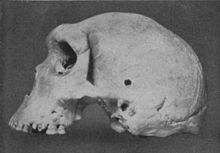
Back Homo rhodesiensis Afrikaans إنسان روديسيا Arabic Homo rhodesiensis Azerbaijani Радэзійскі чалавек Byelorussian Родезийски човек Bulgarian Homo rhodesiensis Catalan Homo rhodesiensis Czech Homo rhodesiensis Danish Homo rhodesiensis German Homo rhodesiensis Greek
| Homo rhodesiensis Temporal range: Middle Pleistocene
| |
|---|---|

| |
| Kabwe skull (1922 photograph) | |
| Scientific classification | |
| Domain: | Eukaryota |
| Kingdom: | Animalia |
| Phylum: | Chordata |
| Class: | Mammalia |
| Order: | Primates |
| Suborder: | Haplorhini |
| Infraorder: | Simiiformes |
| Family: | Hominidae |
| Subfamily: | Homininae |
| Tribe: | Hominini |
| Subtribe: | Hominina |
| Genus: | Homo |
| Species: | †H. rhodesiensis
|
| Binomial name | |
| †Homo rhodesiensis Woodward, 1921
| |
Homo rhodesiensis is the species name proposed by Arthur Smith Woodward (1921) to classify Kabwe 1 (the "Kabwe skull" or "Broken Hill skull", also "Rhodesian Man"), a Middle Stone Age fossil recovered from Broken Hill mine in Kabwe, Northern Rhodesia (now Zambia).[1] In 2020, the skull was dated to 324,000 to 274,000 years ago. Other similar older specimens also exist.[2]
H. rhodesiensis is now widely considered a synonym of H. heidelbergensis.[3] Other designations such as Homo sapiens arcaicus[4] and Homo sapiens rhodesiensis[5] have also been proposed.
- ^ "GBIF 787018738 Fossil of Homo rhodesiensis Woodward, 1921". GBIF org. Retrieved December 9, 2015.
- ^ Grün, Rainer; Pike, Alistair; McDermott, Frank; Eggins, Stephen; Mortimer, Graham; Aubert, Maxime; Kinsley, Lesley; Joannes-Boyau, Renaud; Rumsey, Michael; Denys, Christiane; Brink, James; Clark, Tara; Stringer, Chris (2020-04-01). "Dating the skull from Broken Hill, Zambia, and its position in human evolution" (PDF). Nature. 580 (7803): 372–375. Bibcode:2020Natur.580..372G. doi:10.1038/s41586-020-2165-4. ISSN 1476-4687. PMID 32296179. S2CID 214736650.
- ^ Ni, Xijun; Ji, Qiang; Wu, Wensheng; Shao, Qingfeng; Ji, Yannan; Zhang, Chi; Liang, Lei; Ge, Junyi; Guo, Zhen; Li, Jinhua; Li, Qiang; Grün, Rainer; Stringer, Chris (2021-08-28). "Massive cranium from Harbin in northeastern China establishes a new Middle Pleistocene human lineage". The Innovation. 2 (3): 100130. Bibcode:2021Innov...200130N. doi:10.1016/j.xinn.2021.100130. ISSN 2666-6758. PMC 8454562. PMID 34557770.
- ^ H. James Birx (10 June 2010). 21st Century Anthropology: A Reference Handbook. SAGE Publications. p. 48. ISBN 978-1-4522-6630-5.
- ^ Bernard Wood (31 March 2011). Wiley-Blackwell Encyclopedia of Human Evolution, 2 Volume Set. John Wiley & Sons. pp. 761–762. ISBN 978-1-4443-4247-5.